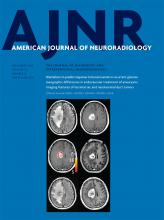Index by author
Dousset, V.
- FELLOWS' JOURNAL CLUBSpine Imaging and Spine Image-Guided InterventionsOpen AccessCervical Spinal Cord DTI Is Improved by Reduced FOV with Specific Balance between the Number of Diffusion Gradient Directions and AveragesA. Crombe, N. Alberti, B. Hiba, M. Uettwiller, V. Dousset and T. TourdiasAmerican Journal of Neuroradiology November 2016, 37 (11) 2163-2170; DOI: https://doi.org/10.3174/ajnr.A4850
The authors evaluated multiple parameters of reduced-FOV DTI to optimize image quality. Fifteen healthy individuals underwent cervical spinal cord 3T MRI, including an anatomic 3D Multi-Echo Recombined Gradient Echo, high-resolution full-FOV DTI with a NEX of 3 and 20 diffusion gradient directions, and 5 sets of reduced-FOV DTIs differently balanced in terms of NEX/number of diffusion gradient directions. Qualitatively, reduced-FOV DTI sequences with a NEX of >5 were significantly better rated than the full-FOV DTI and the reduced-FOV DTI with low NEX (N=3) and a high number of diffusion gradient directions (D=20). Quantitatively, the best trade-off was reached by the reduced-FOV DTI with a NEX of 9 and 9 diffusion gradient directions. They conclude that the best compromise was obtained with a NEX of 9 and 9 diffusion gradient directions, which emphasizes the need for increasing the NEX at the expense of the number of diffusion gradient directions for spinal cord DTI, unlike brain imaging.
Durand, D.
- You have accessRegarding “Endovascular Treatment of Very Small Intracranial Aneurysms: Meta-Analysis”X. Wu, V.B. Kalra, D. Durand and A. MalhotraAmerican Journal of Neuroradiology November 2016, 37 (11) E74-E75; DOI: https://doi.org/10.3174/ajnr.A4906
Eisenmenger, L.B.
- FELLOWS' JOURNAL CLUBExtracranial VascularOpen AccessVitamin D and Vulnerable Carotid PlaqueJ.S. McNally, T.M. Burton, B.W. Aldred, S.-E. Kim, M.S. McLaughlin, L.B. Eisenmenger, G.J. Stoddard, J.J. Majersik, D.V. Miller, G.S. Treiman and D.L. ParkerAmerican Journal of Neuroradiology November 2016, 37 (11) 2092-2099; DOI: https://doi.org/10.3174/ajnr.A4849
Angiotensin II stimulates intraplaque hemorrhage in animal models, and the angiotensin system is highly regulated by vitamin D. The authors' purpose was to determine whether low vitamin D levels predict carotid intraplaque hemorrhage (IPH). In this cross-sectional study, 65 patients with carotid disease underwent carotid MR imaging and blood draw. Systemic clinical confounders and local lumen imaging markers were recorded. They performed multivariable Poisson regression by using generalized estimating equations to account for up to 2 carotid arteries per patient and backward elimination of confounders. The authors found that low vitamin D levels (<30 ng/mL) were a significant predictor of MRI-detected IPH, along with plaque thickness. They conclude that vitamin D insufficiency was associated with both the presence and volume of carotid IPH in patients with carotid atherosclerosis and that these results link low vitamin D levels with plaque vulnerability.
English, J.
- NeurointerventionYou have accessGeographic Differences in Endovascular Treatment and Retreatment of Cerebral AneurysmsA.S. Turk, S.C. Johnston, S. Hetts, J. Mocco, J. English, Y. Murayama, C.J. Prestigiacomo, D. Lopes, Y.P. Gobin, K. Carroll and C. McDougallAmerican Journal of Neuroradiology November 2016, 37 (11) 2055-2059; DOI: https://doi.org/10.3174/ajnr.A4857
Enzinger, C.
- Adult BrainYou have accessA Semiautomatic Method for Multiple Sclerosis Lesion Segmentation on Dual-Echo MR Imaging: Application in a Multicenter ContextL. Storelli, E. Pagani, M.A. Rocca, M.A. Horsfield, A. Gallo, A. Bisecco, M. Battaglini, N. De Stefano, H. Vrenken, D.L. Thomas, L. Mancini, S. Ropele, C. Enzinger, P. Preziosa and M. FilippiAmerican Journal of Neuroradiology November 2016, 37 (11) 2043-2049; DOI: https://doi.org/10.3174/ajnr.A4874
Erceg, G.
- INTERVENTIONALOpen AccessVirtual-versus-Real Implantation of Flow Diverters: Clinical Potential and Influence of Vascular GeometryP. Bouillot, O. Brina, H. Yilmaz, M. Farhat, G. Erceg, K.-O. Lovblad, M.I. Vargas, Z. Kulcsar and V.M. PereiraAmerican Journal of Neuroradiology November 2016, 37 (11) 2079-2086; DOI: https://doi.org/10.3174/ajnr.A4845
Esmaeli, B.
- FELLOWS' JOURNAL CLUBHead and Neck ImagingYou have accessImaging Features of Malignant Lacrimal Sac and Nasolacrimal Duct TumorsV.A. Kumar, B. Esmaeli, S. Ahmed, B. Gogia, J.M. Debnam and L.E. GinsbergAmerican Journal of Neuroradiology November 2016, 37 (11) 2134-2137; DOI: https://doi.org/10.3174/ajnr.A4882
This case series presents 18 patients with primary and secondary malignant lacrimal sac and nasolacrimal duct tumors and their pattern of tumor spread. Squamous cell carcinoma was the most common histology and, in 15/18 patients tumor involved both the lacrimal sac and duct at the time of diagnosis. In 11/16 patients on CT, the nasolacrimal bony canal was smoothly expanded without erosive changes. Tumor was not observed solely within the nasolacrimal duct in any patient. Only 1 patient presented with nodal metastasis and there was no intracranial tumor extension or perineural tumor spread. The authors conclude that malignant lacrimal sac and nasolacrimal duct tumors tend to expand the nasolacrimal bony canal, rather than erode it. CT was superior to MR imaging in characterizing expansion versus erosion of the nasolacrimal bony canal.
Farhat, M.
- INTERVENTIONALOpen AccessVirtual-versus-Real Implantation of Flow Diverters: Clinical Potential and Influence of Vascular GeometryP. Bouillot, O. Brina, H. Yilmaz, M. Farhat, G. Erceg, K.-O. Lovblad, M.I. Vargas, Z. Kulcsar and V.M. PereiraAmerican Journal of Neuroradiology November 2016, 37 (11) 2079-2086; DOI: https://doi.org/10.3174/ajnr.A4845
Faro, S.H.
- Pediatric NeuroimagingOpen AccessDiffusion Tensor Imaging of the Normal Cervical and Thoracic Pediatric Spinal CordS. Saksena, D.M. Middleton, L. Krisa, P. Shah, S.H. Faro, R. Sinko, J. Gaughan, J. Finsterbusch, M.J. Mulcahey and F.B. MohamedAmerican Journal of Neuroradiology November 2016, 37 (11) 2150-2157; DOI: https://doi.org/10.3174/ajnr.A4883
Fernandez-ruiz, J.
- ADULT BRAINOpen AccessAtaxia Severity Correlates with White Matter Degeneration in Spinocerebellar Ataxia Type 7C.R. Hernandez-Castillo, I. Vaca-Palomares, F. Barrios, L. Martinez, M.-C. Boll and J. Fernandez-RuizAmerican Journal of Neuroradiology November 2016, 37 (11) 2050-2054; DOI: https://doi.org/10.3174/ajnr.A4903








